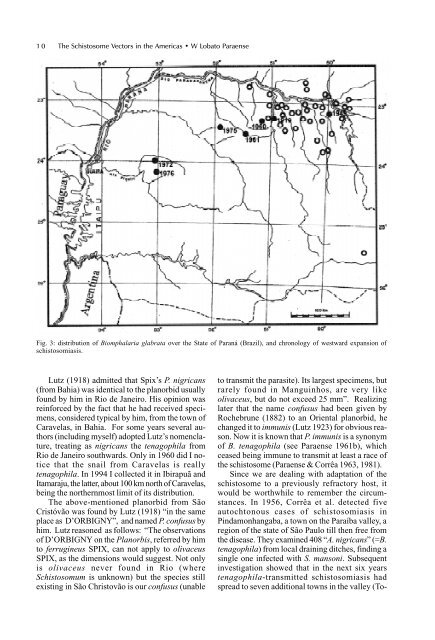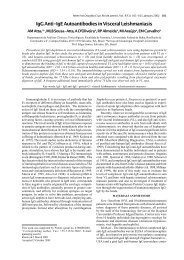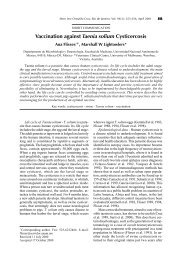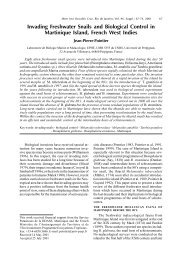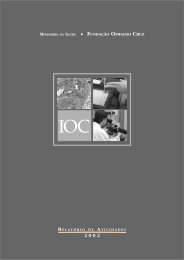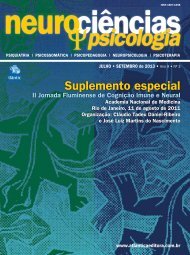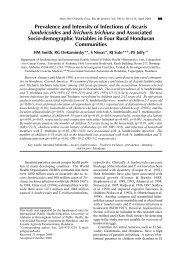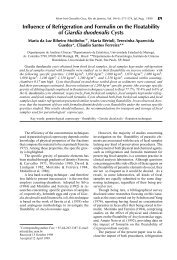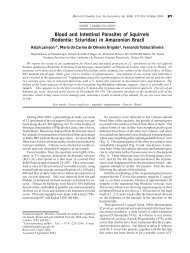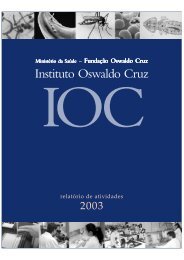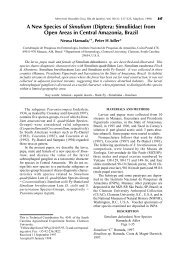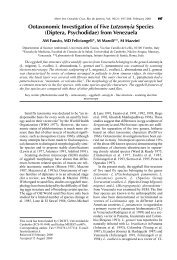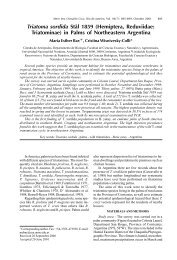The Schistosome Vectors in the Americas - SciELO
The Schistosome Vectors in the Americas - SciELO
The Schistosome Vectors in the Americas - SciELO
Create successful ePaper yourself
Turn your PDF publications into a flip-book with our unique Google optimized e-Paper software.
10 <strong>The</strong> <strong>Schistosome</strong> <strong>Vectors</strong> <strong>in</strong> <strong>the</strong> <strong>Americas</strong> • W Lobato Paraense<br />
Fig. 3: distribution of Biomphalaria glabrata over <strong>the</strong> State of Paraná (Brazil), and chronology of westward expansion of<br />
schistosomiasis.<br />
Lutz (1918) admitted that Spix’s P. nigricans<br />
(from Bahia) was identical to <strong>the</strong> planorbid usually<br />
found by him <strong>in</strong> Rio de Janeiro. His op<strong>in</strong>ion was<br />
re<strong>in</strong>forced by <strong>the</strong> fact that he had received specimens,<br />
considered typical by him, from <strong>the</strong> town of<br />
Caravelas, <strong>in</strong> Bahia. For some years several authors<br />
(<strong>in</strong>clud<strong>in</strong>g myself) adopted Lutz’s nomenclature,<br />
treat<strong>in</strong>g as nigricans <strong>the</strong> tenagophila from<br />
Rio de Janeiro southwards. Only <strong>in</strong> 1960 did I notice<br />
that <strong>the</strong> snail from Caravelas is really<br />
tenagophila. In 1994 I collected it <strong>in</strong> Ibirapuã and<br />
Itamaraju, <strong>the</strong> latter, about 100 km north of Caravelas,<br />
be<strong>in</strong>g <strong>the</strong> nor<strong>the</strong>rnmost limit of its distribution.<br />
<strong>The</strong> above-mentioned planorbid from São<br />
Cristóvão was found by Lutz (1918) “<strong>in</strong> <strong>the</strong> same<br />
place as D’ORBIGNY”, and named P. confusus by<br />
him. Lutz reasoned as follows: “<strong>The</strong> observations<br />
of D’ORBIGNY on <strong>the</strong> Planorbis, referred by him<br />
to ferrug<strong>in</strong>eus SPIX, can not apply to olivaceus<br />
SPIX, as <strong>the</strong> dimensions would suggest. Not only<br />
is olivaceus never found <strong>in</strong> Rio (where<br />
Schistosomum is unknown) but <strong>the</strong> species still<br />
exist<strong>in</strong>g <strong>in</strong> São Christovão is our confusus (unable<br />
to transmit <strong>the</strong> parasite). Its largest specimens, but<br />
rarely found <strong>in</strong> Mangu<strong>in</strong>hos, are very like<br />
olivaceus, but do not exceed 25 mm”. Realiz<strong>in</strong>g<br />
later that <strong>the</strong> name confusus had been given by<br />
Rochebrune (1882) to an Oriental planorbid, he<br />
changed it to immunis (Lutz 1923) for obvious reason.<br />
Now it is known that P. immunis is a synonym<br />
of B. tenagophila (see Paraense 1961b), which<br />
ceased be<strong>in</strong>g immune to transmit at least a race of<br />
<strong>the</strong> schistosome (Paraense & Corrêa 1963, 1981).<br />
S<strong>in</strong>ce we are deal<strong>in</strong>g with adaptation of <strong>the</strong><br />
schistosome to a previously refractory host, it<br />
would be worthwhile to remember <strong>the</strong> circumstances.<br />
In 1956, Corrêa et al. detected five<br />
autochtonous cases of schistosomiasis <strong>in</strong><br />
P<strong>in</strong>damonhangaba, a town on <strong>the</strong> Paraíba valley, a<br />
region of <strong>the</strong> state of São Paulo till <strong>the</strong>n free from<br />
<strong>the</strong> disease. <strong>The</strong>y exam<strong>in</strong>ed 408 “A. nigricans” (=B.<br />
tenagophila) from local dra<strong>in</strong><strong>in</strong>g ditches, f<strong>in</strong>d<strong>in</strong>g a<br />
s<strong>in</strong>gle one <strong>in</strong>fected with S. mansoni. Subsequent<br />
<strong>in</strong>vestigation showed that <strong>in</strong> <strong>the</strong> next six years<br />
tenagophila-transmitted schistosomiasis had<br />
spread to seven additional towns <strong>in</strong> <strong>the</strong> valley (To-


